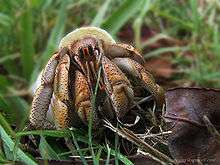Australian land hermit crab
| Australian land hermit crab | |
|---|---|
 | |
| Scientific classification | |
| Kingdom: | Animalia |
| Phylum: | Arthropoda |
| Subphylum: | Crustacea |
| Class: | Malacostraca |
| Order: | Decapoda |
| Family: | Coenobitidae |
| Genus: | Coenobita |
| Species: | C. variabilis |
| Binomial name | |
| Coenobita variabilis McCulloch, 1909 | |
The Australian land hermit crab (Coenobita variabilis) is a terrestrial hermit crab species, native to Australia. It is a nocturnal, omnivorous crustacean. They are gregarious and thrive in tropical areas near water.
Distribution
The Australian land hermit crab is endemic to northern parts of Australia including northern Western Australia, Northern Territory and northern Queensland.[1]
Biology
The Australian land hermit crab (Coenobita variabilis) reaches a carapace length of 40 millimetres (1.6 in).[2] They closely resemble the Pacific hermit crab (Coenobita compressus) in appearance and they both have a shortened aquatic development stage.[3]
Australian hermit crabs are light brown to pale brown in colour, with two dark ovals on the front of the head. Their eyestalks are long and are the same colour as the body. Each claw has a dark vertical stripe. They have dark brown spots all over the legs. The abdomen is short and fat.
Shell preference

The preferred seashells of C. variabilis include Babylonia, Nerita, Phasianella, Thais, Tonna and Turban seashells. They are also found to be fond of several varieties of land snail shells such as Aratan snail and rice snail.
As the hermit crabs grow, they must exchange their shell for a larger one. Since intact gastropod shells are not an unlimited resource, there is frequently strong competition for the available shells, with hermit crabs fighting over shells.[2] The availability of empty shells depends on the abundance of the gastropods and hermit crabs, but most importantly on the frequency of organisms that prey on gastropods but leave the shells intact. A hermit crab with a shell which is too tight cannot grow as fast as hermit crabs with well-fitting shells, and is more likely to be eaten. Although hermit crabs need to change shells regularly, they will not abandon their old shell unless they have a larger and newer one to change into and unless they feel safe.
Further reading
- Diana S. Jones & Gary J. Morgan (1994). A Field Guide to Crustaceans of Australian Waters. Chatswood, New South Wales: Western Australian Museum. ISBN 0-7301-0403-6.
References
- ↑ P. J. F. Davie, ed. (2002). "Coenobitidae". Crustacea: Malocostraca: Eucarida (Part 2), Decapoda: Anomura, Brachyura. Volume 19 of Zoological catalogue of Australia, Australia. CSIRO Publishing. pp. 33–35. ISBN 978-0-643-06792-9.
- 1 2 Keith Davey. "Coenobita variabilis (Family Coenobitidae). Terrestrial Hermit Crab". SpeciesBank. Department of the Environment, Water, Heritage and the Arts.
- ↑ A. Harvey & R. Brodie (2001). "Development of the terrestrial hermit crab, Coenobita compressus, in the laboratory". Journal of Crustacean Biology. 21 (3): 715–732. doi:10.1651/0278-0372(2001)021[0715:LDOTLH]2.0.CO;2. ISSN 0278-0372.


